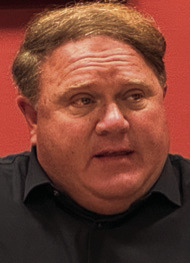Political middle' key to House race
By By William F. West / community editor
Aug. 12, 2002
A longtime expert and observer said he believes the political middle is the key to whether U.S. Rep. Chip Pickering or U.S. Rep. Ronnie Shows will represent the new 3rd Congressional District for the next two years.
Marty Wiseman, 51, runs the Stennis Institute of Government at Mississippi State University. The institute, named for the late Sen. John C. Stennis, is a think tank offering analyses to governments and the press.
And what's Wiseman's take on the Pickering-Shows contest?
The most identifiable constituencies are the African-Americans, who traditionally side with the Democrats, and the white, Main Street business and professional types, who traditionally side with the Republicans.
Shows is a Democrat with moderate to conservative leanings. Pickering is a Republican with solidly conservative credentials.
Pickering, 38, a former Baptist missionary, worked as an aide to Sen. Trent Lott before winning election to Congress in 1996. Shows, 55, a former schoolteacher and coach, was a circuit clerk, state senator and state transportation commissioner before winning election to Congress in 1998.
The two were paired against each because the state's lagging population trends resulted in the loss of a congressional seat.
Populist rhetoric
One factor in the contest could be the use of populist rhetoric and tactics, that is, the direct political appeal to the working class against the elite.
Shows has made clear his support of workers and is airing television advertisements to back it up.
Pickering is airing television ads citing his conservatism but also showing him with his family in more casual clothing, instead of in the young Southern businessman attire readily visible in most news photographs.
Populism, in either mild or strong doses, can be a strong attraction.
Sen. Huey Long of Louisiana used it to build a powerful political machine in the Bayou State, and his brother, Earl, kept it going as governor.
Closer to home, Sens. James K. Vardaman and Theodore G. Bilbo of Mississippi and Gov. George C. Wallace of Alabama also skillfully used it to build followings of blue-collar workers and redneck farmers.
However, the rhetoric espoused by Vardaman, Bilbo and Wallace was rooted in the white racist opposition to equal rights for blacks. Wallace's brand of populism also including nose-thumbing and snarling at eastern liberal newsmen, politicians and professors.
Things have changed radically since Southern blacks won the right to vote and many Southern white conservatives transferred their political allegiance to the Republican Party.
In Mississippi, Democratic Govs. Cliff Finch and Bill Allain and Rep. Wayne Dowdy saw the changing dynamics and responded by cultivating what experts call the "blackneck" coalition, that is, an unbeatable alliance of both African-Americans and working-class whites against big corporations and utilities.
Effective strategy
Such a strategy helped defeat Republican gubernatorial candidates Gil Carmichael and Leon Bramlett and Republican congressional candidates Liles Williams and David Armstrong.
Wiseman particularly recalls Finch's colorful, gimmick-filled campaign, which was readily identifiable by his toting a working man's lunch box to various jobs.
It's the kind of populist tactics that go at least as far back as Bilbo, who was perhaps one of the nation's most vicious racists, but also one who knew how to whip up crowds, particularly in southern Mississippi, with rantings and speeches against fat cats.
Today, "it's an economic thing, rather than a racial thing," Wiseman said.













